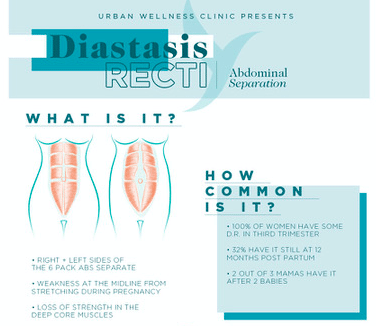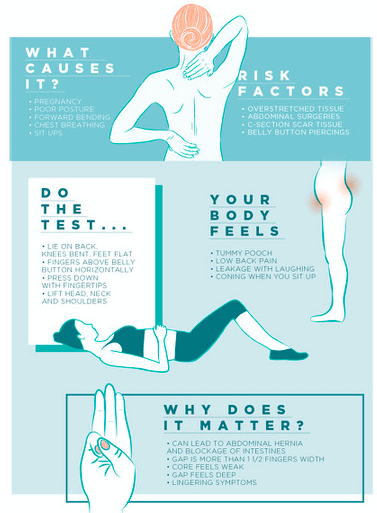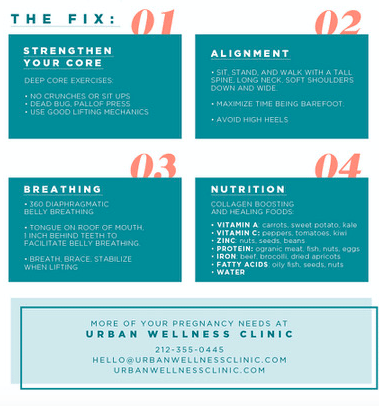How to Heal Diastasis Recti Without Surgery
After having Victoria 5 years ago exactly today, I realized that regardless of how much I worked out I had a mom pooch. There was zero way around it. This pouch on my frame makes me look about 2-3 months pregnant. I’ll be honest with you… it embarrasses me. I just always feel conscious about it. I mean, ALWAYS.
I have Diastasis Recti. Fortunately it’s something that’s fairly common with women, especially after multiple births. There is actually a name for what I have, not just… mom pooch!
I was told that surgery was and would be the only option.
I was wrong.
Dr. Emily Kiberd reached out to me and shared some incredible information as to how you could work on healing your Diastasis Recti. It was fascinating to me because I loved that there was things I could do to be more proactive. I’m excited to share some graphics Dr. Kiberd sent me, along with an interview.



1. Dr. Kiberd – How do you determine if a woman has Diastasis?
There are physical tell tale signs that a woman may have Diastasis Recti or abdominal separation. These signs include low back pain, hip tightness, a pooch around the belly button and lower abdomen, and a vertical bulge when they try to do a sit up. We call this bulge coning and looks something like this:
There’s a great test a woman can do on her own to check to see if she has Diastasis Recti.
Lay out your back with knees bent and feet on the floor under your knees. Place three fingers flat horizontally at the belly button. Now lift your head as you pull your chin to your chest. You should feel the inner sides of your six pack or rectus abdominus muscles close together. Normal distance between the sides of your 6 pack is 1-1.5 finger width. Anything wider is considered a separation that needs to be closed.
Lay the head back down on the ground and check above the belly button all the way up to the bottom of the chest bone or sternum. Also make sure to check down below the belly button as well.
Here are some common variations of Diastasis you may find as you rest your own:
(Photo 1)
2. Is Diastasis dangerous for a woman to have? I personally have it and have always wondered if I was going to do anything to it by lifting anything heavy.
Diastasis Recti is normal in 100% of women who give birth, about 35% of women have it one year after giving birth. Diastasis recti can lead to an abdominal hernia or bulging of the intestines through the wall that holds all your organs in. If the intestines get stuck, they can be strangled and lead to a cut off of blood supply to the intestines. This is special emergency that requires surgery.
The more long term concern is diastasis recti is a sign of weak core muscles and a lack of core stability. A weak core can lead to disc herniations, chronic low back pain, SI Joint pain, and pain down the leg.
3. Is there anyway to correct Diastasis without surgery?
Absolutely. We see Diastasis close in our office on our massage table and stay closed with a home exercise program. This home exercise program involved three concepts:
Breath, Braced, and Stacked.
Most women suck in and breathe short shallow breaths into the chest. Properly breathing mechanics involve a breath down and wide into the belly when we breathe in. As we breathe out, the belly softens. This is hard for most women to do, so the best way to reconnect with your breath is to lay face down and breathe down towards your hip points, wide into your waistline and into your low back. With the belly on the floor this is a great place to get sensory feedback of where to breathe.
When we lift our babies, we should breathe down and wide and then brace. What is a brace? This is to keep the tension in your belly and create a canister of strength in your belly while lifting. Some women will suck the belly in towards the spine when lifting which puts pressure on the spine and can increase diastasis recti.
Lastly, get stacked. Sometimes as we hold our sweet babies, we will over arch our back and jut a hip. This can lead to cranky hips and a stiff low back. Getting stacked lines the diaphragm up over the pelvis and stacking the ears over the shoulders over the hips.
After we get a good belly breath, a brace on the exhale, and stacked, activating the oblique slings will help close the separation. We do this through these kinds of functional progressions from a technique called BIRTHFIT.
Check out these videos here for the 4 part series of the functional progressions.
https://www.birthfitwisconsin.com/functional-progression
4. If a woman has had it for years, is there still hope for a non-surgical heal? I’ve had mine for 5 years.
Absolutely! We see it every day. The better the breath, the stronger the core, and the better the lifting mechanics, the faster diastasis can close.
5. How does one get Diastasis?
Most times diastasis is caused by a weak core, short shallow chest breathing, sway back, poor lifting mechanics, and sometimes old surgeries can lead abdominal separation.
For more information, we have a whole section on how to heal after pregnancy and thoughts on motherhood.
Check out more here from Urban Wellness Clinic – urbanwellnessclinic.com






